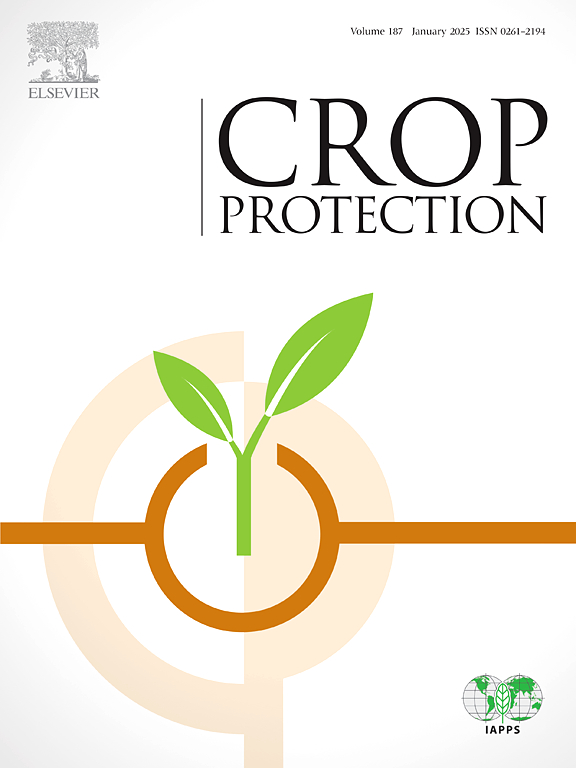Factors influencing management of Black Sigatoka disease of banana and plantain in the South-West Region of Cameroon
IF 2.5
2区 农林科学
Q1 AGRONOMY
引用次数: 0
Abstract
Bananas and plantains are major cash crops in Cameroon, contributing significantly to the national economy and the livelihoods of farmers. However, Black Sigatoka disease (BSD) severely affects the production of these crops, particularly among smallholder farmers. This study examines the control methods used by farmers and the factors influencing their choices in managing BSD. Data were collected from 322 smallholder banana and plantain farmers in the Limbe and Buea districts of Cameroon in 2022. A combination of descriptive statistics and multinomial logistic regression was used to analyze the data. Descriptive results reveal that 78.6 % of farmers have encountered BSD, with the most reported symptoms being black streaks, black dots, and dry patches on leaves (41.6 %). Farmers reported significant negative impacts of BSD on the selling price (62.4 %) and yield (55.3 %) of bananas and plantains. The findings indicate that chemical control methods, such as fungicide applications, are the most commonly used approach (69.9 %), while fewer farmers adopt non-chemical methods, including removing infected leaves and improving field sanitation. Multinomial logistic regression results show that older farmers, religious farmers, those with more farming experience, larger landholdings, and access to extension services are less likely to use non-chemical control methods. In contrast, farmers who are more educated, have received training, consider agriculture their main occupation, and primarily cultivate bananas and plantains are more likely to adopt non-chemical practices. We recommend providing targeted training on non-chemical BSD management methods and equipping extension workers to effectively disseminate this knowledge to farmers.
影响喀麦隆西南地区香蕉和大蕉黑叶斑病管理的因素
香蕉和大蕉是喀麦隆的主要经济作物,对国民经济和农民生计作出了重大贡献。然而,黑叶斑病(BSD)严重影响这些作物的生产,特别是在小农中。本研究考察了农民在管理BSD时使用的控制方法以及影响他们选择的因素。数据于2022年从喀麦隆Limbe和Buea地区的322名香蕉和大蕉小农中收集。采用描述性统计和多项逻辑回归相结合的方法对数据进行分析。描述性结果显示,78.6%的农民遇到过BSD,报告的症状最多的是黑色条纹、黑点和叶片上的干斑(41.6%)。农民报告说,BSD对香蕉和大蕉的销售价格(62.4%)和产量(55.3%)产生了显著的负面影响。调查结果表明,化学防治方法,如施用杀菌剂,是最常用的方法(69.9%),而较少的农民采用非化学方法,包括去除受感染的叶子和改善田地卫生。多项逻辑回归结果显示,年龄较大的农民、有宗教信仰的农民、有更多农业经验的农民、拥有更大土地的农民和获得推广服务的农民不太可能使用非化学防治方法。相比之下,那些受教育程度较高、接受过培训、以农业为主要职业、主要种植香蕉和大蕉的农民更有可能采用非化学方法。我们建议就非化学品BSD管理方法提供有针对性的培训,并为推广人员提供装备,以便有效地向农民传播这方面的知识。
本文章由计算机程序翻译,如有差异,请以英文原文为准。
求助全文
约1分钟内获得全文
求助全文
来源期刊

Crop Protection
农林科学-农艺学
CiteScore
6.10
自引率
3.60%
发文量
200
审稿时长
29 days
期刊介绍:
The Editors of Crop Protection especially welcome papers describing an interdisciplinary approach showing how different control strategies can be integrated into practical pest management programs, covering high and low input agricultural systems worldwide. Crop Protection particularly emphasizes the practical aspects of control in the field and for protected crops, and includes work which may lead in the near future to more effective control. The journal does not duplicate the many existing excellent biological science journals, which deal mainly with the more fundamental aspects of plant pathology, applied zoology and weed science. Crop Protection covers all practical aspects of pest, disease and weed control, including the following topics:
-Abiotic damage-
Agronomic control methods-
Assessment of pest and disease damage-
Molecular methods for the detection and assessment of pests and diseases-
Biological control-
Biorational pesticides-
Control of animal pests of world crops-
Control of diseases of crop plants caused by microorganisms-
Control of weeds and integrated management-
Economic considerations-
Effects of plant growth regulators-
Environmental benefits of reduced pesticide use-
Environmental effects of pesticides-
Epidemiology of pests and diseases in relation to control-
GM Crops, and genetic engineering applications-
Importance and control of postharvest crop losses-
Integrated control-
Interrelationships and compatibility among different control strategies-
Invasive species as they relate to implications for crop protection-
Pesticide application methods-
Pest management-
Phytobiomes for pest and disease control-
Resistance management-
Sampling and monitoring schemes for diseases, nematodes, pests and weeds.
 求助内容:
求助内容: 应助结果提醒方式:
应助结果提醒方式:


